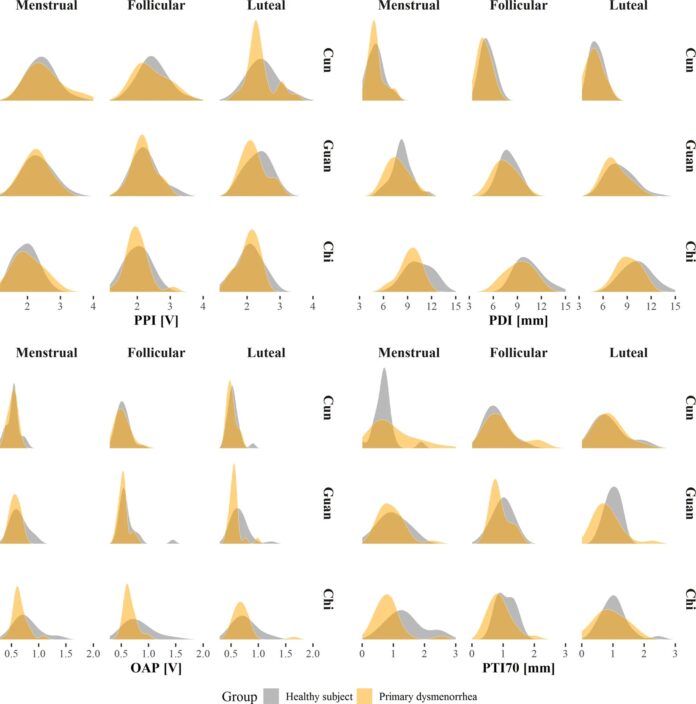
The research team proved index information that can be used as a reference for medical treatment guidelines in acupuncture, moxibustion, and herbal medicine.
By Namwook Cho L.Ac.
The team of Young Ju Jeon from Future Medicine Division, Korea Institute of Oriental Medicine and 6 other researchers studied pulses of the total 48 females (aged 20 to 29 years) with 24 primary dysmenorrhea (PD) and 24 healthy subjects in order to compare the differences of pulse tension and depth.
The radial pulse of each subject was obtained using a pulse tonometric device which is able to convert human pulse to electric signal for measuring, during menstrual, follicular, and luteal phases.
Test result was PD patients’ pulse tension and the depth were significantly lower than those in the healthy group during the menstrual phase. The result matched with traditional acupuncture theory that tight pulse which is felt as taut and strong like a stretched twisted rope and its indications are cold, food retention, and pain.
The research leader Doctor Jeon explained that “this information on pulse depth, width, length, regularity, and tension can be used as a reference for medical treatment guidelines in acupuncture, moxibustion, and herbal medicine.”
The research was published on last July at Scientific Reports, Nature and research title is “A comparative study of the radial pulse between primary dysmenorrhea patients and healthy subjects during the menstrual phase.”
Recently, a group of South Korean researchers successfully proved that pulse reading was really working by analyzing electric strength and depth.
One of the most common diagnostic methods for acupuncturists is radial pulse reading. However, serious problems can arise due to reliance on the physician’s subjective point of view. The accuracy of pulse diagnosis depends on the individual’s experience, observational skills, and fingertip sensitivity.
The team of Young Ju Jeon from Future Medicine Division, Korea Institute of Oriental Medicine and 6 other researchers studied pulses of the total 48 females (aged 20 to 29 years) with 24 primary dysmenorrhea (PD) and 24 healthy subjects in order to compare the differences of pulse tension and depth. PD is defined as cramp-like pain in the lower abdomen before or during menstruation without any related diseases.
The radial pulse of each subject was obtained using a pulse tonometric device during menstrual, follicular, and luteal phases.
Test result was PD patients’ pulse tension and the depth were significantly lower than those in the healthy group during the menstrual phase. The result matched with traditional acupuncture theory that thight pulse which is felt as taut and strong like a stretched twisted rope and its indications are cold, food retention, and pain.
The pulse tension index (PTI) and pulse depth index (PDI) in the patient group were significantly lower than those in the healthy group during the menstrual phase (P < 0.01 and <0.001, respectively). According to univariate logistic regression results, the PTI, PDI and optimal applied pressure (OAP) were significantly correlated with PD, and the model based on the PTI and OAP performed best (AUC = 0.828).
The research leader, Doctor Jeon explained that “we believe that this study provides a basis for further and more comprehensive studies. This study is the first among the current literature to investigate radial pulse indices focusing only on the chi pulses of PD patients throughout the menstrual cycle using a PTD.”
She added, “this is the first study to analyze pulse tension by developing the PTI and applying it to clinical practice. This information on pulse depth, width, length, regularity, and tension can be used as a reference for medical treatment guidelines in acupuncture, moxibustion, and herbal medicine.”
The results of this study confirmed the possibility of quantitatively measuring pulse tension, which could also provide a scientific perspective on the development of the PTD.
The research was published on last July at Scientific Reports, Nature and research title is “A comparative study of the radial pulse between primary dysmenorrhea patients and healthy subjects during the menstrual phase.”


































